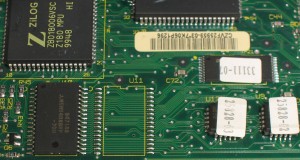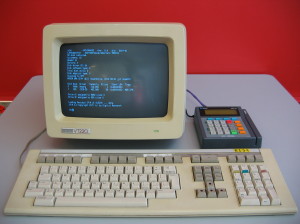
This image shows the flash chip in the upper right. The memory chip is shown on the lower left and the two PAL chips appear on the lower right.
As the flash chip holds the main program of the terminal, I needed to find some way to obtain the contents. Removing the chip itself and reading it in a programmer was an option, but risky and requiring tools I do not have. Removing it would also leave me with the task of soldering the chip back into place.
I realized that the device itself was programmable, and, thus, must hold some code inside to reprogram the flash. I needed to target that procedure. First, I would need to obtain the protocol to initiate and complete the reprogramming.
Verifone documents the button sequence required to access the local operating system and program one device from another, but not the transfer protocol used between the devices.
I would need the assistance of another tool to obtain the current running code and view what was happening within the device in order to make further progress.
Fortunately, I had just purchased cables and pods for my logic analyzer, which was to be of significant assistance in this entire process.
